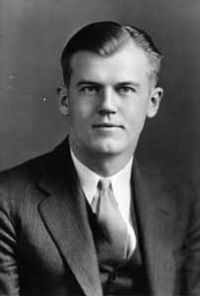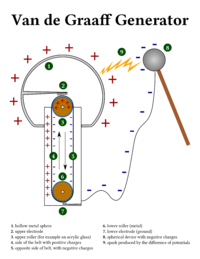Robert J. Van de Graaff
Claimed by Rebecca Kobernat
Robert Jemison Van de Graaff (December 20, 1901 – January 16, 1967) was an American physicist, of Dutch descent, who designed and created his namesake high-voltage generator.

Personal Life and Education
Van de Graaff was born in Tuscaloosa, Alabama as the fourth son of Minnie and Adrian Van de Graaff. After receiving his master's degree from the University of Alabama in 1923, Van de Graaff worked for the Alabama Power company for a year. He then studied at the Sarbonne in France for a year before attending Oxford University as a Rhodes Scholar, where he received his second BS degree and completed his PhD in 1928.
In 1936 he married Catherine Boyden, with whom he had two sons, John and William. Robert J Van de Graaff died in Boston at age 65.
Career
Van de Graaff returned to the United States in 1929 as a National Research Fellow at Princeton University. It was there that he created his first electrostatic generator, with the help of Nicholas Burke. He left Princeton and became a research associate at MIT in 1931. He received a patent for his generator in 1935, the year after he became an associate professor at MIT and he remained in that position until 1960 when he resigned in order to focus his attention on HVEC.
John Trump, an electrical engineering professor at MIT, and Van de Graaff co-founded the High Voltage Engineering Corporation (HVEC) in 1946 for the commercial production of particle accelerators. In the 1950's he invented the insulating core transformer which generated high voltage direct current using magnetic flux, unlike the Van de Graaff generator.
Van de Graaff Generator

Van de Graaff produced the first model of his generator in 1929. It produced 80,000 volts, in comparison, a Van de Graaff generator today can produce up to 7,000,000 volts. Van de Graaff created his generator as a particle accelerator at Princeton University with Nicholas Burke. The generator creates high electric potential using a motorized belt of rubber to carry charge from a high voltage source at one end of the belt to a hollow sphere at the other end. The charge on the outside of the sphere is used to neutralize the inside of the sphere which causes charge to build up on the outer shell while the inside remains neutral thereby creating high potential difference.
Van de Graaff developed a 40-foot tall version of his generator at Massachusetts Institute of Technology in 1933 that had the ability to produce much higher voltages. Another way to produce higher voltages is using a tandem generator which accelerates a particle twice which essentially doubles the voltage produced. Tandem Van de Graaff generators can produce up to 30 million volts. The Van de Graaff generator was the most powerful particle accelerator until the cyclotron was developed by Ernest Lawrence. Van de Graaff generators were used for things such as nuclear medicine, the study of nuclear structure, and radiography.
Interesting Facts
Van de Graaff's three older brothers all played football at the University of Alabama and made the College Football All-Southern Team. His brother William "Bully" Van de Graaff was named to the All-American team in 1915.
Van de Graaff Generator is also the name of a British progressive rock band that was formed in 1967.
Van de Graaff worked with John Trump: MIT electrical engineering professor and uncle of real estate mogul and candidate for the 2016 presidential election, Donald Trump.
See also
References
https://en.wikipedia.org/w/index.php?title=Van_de_Graaff_generator&redirect=no
https://en.wikipedia.org/wiki/Van_der_Graaf_Generator
https://en.wikipedia.org/wiki/Robert_J._Van_de_Graaff
http://tvdg10.phy.bnl.gov/vandegraaff.html